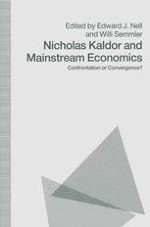1991 | OriginalPaper | Buchkapitel
A Keynesian Business Cycle
verfasst von : R. H. Day, T. Y. Lin
Erschienen in: Nicholas Kaldor and Mainstream Economics
Verlag: Palgrave Macmillan UK
Enthalten in: Professional Book Archive
Aktivieren Sie unsere intelligente Suche, um passende Fachinhalte oder Patente zu finden.
Wählen Sie Textabschnitte aus um mit Künstlicher Intelligenz passenden Patente zu finden. powered by
Markieren Sie Textabschnitte, um KI-gestützt weitere passende Inhalte zu finden. powered by
The Keynesian business cycle follows a straight forward scenario. Begin in an expansion with a rising volume of transactions. Under tight money, interest rates rise. If they rise sharply enough investment is eventually reduced. If this depressing effect is strong enough, a recession is induced by the corresponding fall in aggregate demand; unemployment and excess capacity increase, the transaction demand for money decreases, and the interest rate falls. If the latter influence is sharp enough investment may overcome the depressing influence of excess capacity and low profits. Recovery sets in and the stage is set for a repetition of the story. A dramatic example of such interactions occurred in the early 1980s when the price level was brought under control with tight money policy; interest rates reached unprecedented levels and investment in some sectors came to a virtual standstill. When interest rates eventually fell, the impact on new housing starts and investment was immediate and substantial.
